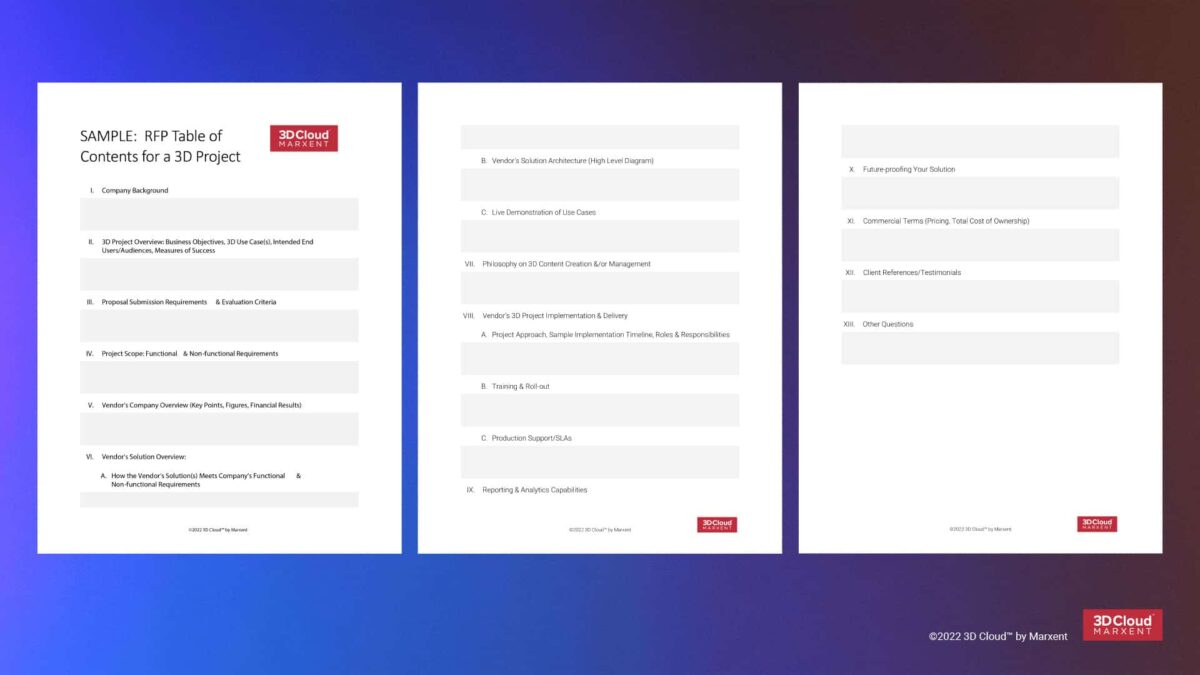Download PDF Template
Download Word Template
Accelerate the 3D Partner evaluation process and increase your confidence in vendor selection with this time-saving resource. Includes downloadable RFP Table of Contents.
This article covers:
- 3D Projects: When should I issue a Request for Proposal (RFP)?
- What should I include in my RFP? Must have elements in your RFP to guide 3D vendor responses
- Sample RFP Table of Contents for 3D projects
The path to evaluating and selecting a vendor for your 3D project may seem daunting. Depending on your project goals, scope, timeline, and budget, it may be appropriate to issue a Request for Proposal (RFP). We’ve created a time-saving resource to help you accelerate this process and ensure you receive meaningful responses from vendors in the 3D space.
This resource is for you if you are an IT, marketing, or strategic sourcing lead evaluating 3D vendors.
3D projects: when should I issue a Request for Proposal (RFP)?
Not every 3D project warrants issuing an RFP. If your business use case is well-defined, and you are already aware of providers and their capabilities but simply need pricing information, you can contact those vendors individually to discuss your project and request a quote.
However, if you are: 1) working on a large, enterprise-wide 3D e-commerce initiative that involves multiple stakeholder groups from your company, 2) you have multiple use cases and want to better understand which 3D vendor(s) can fulfill those use cases, or 3) you are not familiar with prospective vendors in the 3D / augmented reality / virtual reality and need a structured framework for evaluation, then a Request for Proposal (RFP) may be for you. An RFP allows you to collect information from a variety of vendors and choose the one that best meets your needs.
What should I include in my RFP?
As with any RFP, there are some common sections that should be included, such as your Company Overview, Project Goals / Business Objectives, Project Scope, Budget, Submission Requirements, Evaluation Criteria, and Key Contacts. These components should have enough information to help 3D vendors gain an understanding of the current landscape, your business goals and challenges, and who the intended users are for the 3D experiences (consumer, in-house/central design team, in-store associates, contractors, etc.), and how vendors will be evaluated. The risk of having too little information in this portion may yield more questions from respondents and/or a lack of clarity on project goals and scope.
For 3D projects specifically, it’s important to understand the following:
Philosophy and approach to 3D content creation, management, and distribution: Does the respondent have the capability to create 3D models in-house, or is that something you will have to invest in separately? Regarding content ownership, will you own the content, or do those assets belong to the vendor? How easy or difficult is it for your organization to access those assets if you want to use them in other contexts beyond the vendor’s application?
Functional and non-functional requirements for 3D experiences: You need to understand how prospective vendors satisfy your functional and/or non-functional requirements. For functional requirements, distinguish your key priorities and, therefore, non-negotiables to the project scope versus other requirements that may be nice to have but have lower priority. Make sure that the functional requirements you list are relevant to the 3D experience you are asking vendors to respond to. For example, if you list requirements more closely related to 3D product configuration, but the project overview and scope indicate the RFP is for 3D room design and visualization, this creates confusion and may negatively impact the quality of the responses you receive.
Implementation, rollout, and project management: this portion of the RFP is integral for you to understand how providers approach project implementation and delivery, their delivery timelines, and to gauge whether you will truly be supported throughout the project or left to your own devices. It also can give an indication of their speed to market, which either helps accelerate or delay your return on investment (ROI). The best providers will demonstrate a solid track record of performance, balancing speed to market and application quality.
Reporting and analytics capabilities: Speaking of ROI, another hallmark of a strong 3D vendor is how they help report and quantify your return on investment. Access to dashboards and analytics, whether provided by the vendor or via integration with your reporting tools, should help monitor the performance of your 3D app. This is often overlooked in the RFP process but is incredibly valuable when it comes to ongoing monitoring and optimization of 3D experiences. Strong performers will also offer benchmarking capabilities in your category to see how you compare (see related article, “Why Industry Expertise Matters in 3D”).
Other value-added services: The best 3D partners will demonstrate value beyond their fees, including Partner Success programs with onsite and/or virtual training of your teams, assistance in working with your Merchandising and/or Design teams (if applicable) to provide best practices and help with curating content so that you can maximize the value of their platform.
Commercial terms/pricing: Pricing models do vary in the 3D space, so you will want to make sure the respondents articulate what is included in their fees and/or unit pricing to facilitate comparative analysis.
Sample RFP Table of Contents for 3D projects
Below is a sample RFP Table of Contents you can use for your next 3D Project.
- Company Background
- 3D Project Overview: Business Objectives, 3D use case(s), Intended End Users / Audiences, Measures of Success
- Proposal Submission Requirements and Evaluation Criteria
- Project Scope: Functional and Non-Functional requirements
- Vendor’s Company Overview (key points, figures, financial results)
- Vendor’s Solution Overview:
- How does the vendor’s solution(s) meet your company’s functional and non-functional requirements?
- Vendor’s Solution Architecture (high-level diagram)
- Live Demonstration of Use Cases
- Philosophy on 3D Content Creation and/or Management
- Vendor’s 3D Project Implementation & Delivery
- Project Approach, Sample implementation timeline, Roles & Responsibilities
- Training & Rollout
- Production Support / SLAs
- Reporting & Analytics Capabilities
- Future Proofing your solution
- Commercial Terms (Pricing, Total Cost of Ownership)
- Client References / Testimonials
- Other Questions
How to use this tool
- When and how to use the RFP Table of Contents for 3D projects
- Understand the factors to consider when choosing a 3D partner
- Incorporate these RFP components into your e-Sourcing platforms (e.g., Oracle, Workday Sourcing, etc.) to solicit bids from 3D vendors
Downloadable Template
Download the Sample RFP Table of Contents for 3D projects
Download PDF Template
Download Word Template

Once you’ve issued an RFP, what’s next?
With a finished RFP, you are one step closer to launching a successful 3D project. The next step is to evaluate the 3D capabilities of vendors. Contact us today to request a 3D project consultation.
For a complete guide to launching a 3D project, visit our 3D Project Planning Resource Center.













